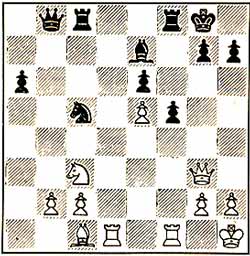|
R A D I O M A T C H R E V I E W E D
|
||
5. MY GAMES WITH KOTOV by Isaac Kashdan CHESS REVIEW DECEMBER 1945 |
33 Q-K2 ….. Hoping to exchange and avert mating threats.
33 ….. Q-Q3 Here the game was adjourned. 37 Q-K2?? ….. A mental aberration. But anything can happen after some 15 hours of play the previous day. 37 ….. Q-B5! Simultaneously threatening mate and Knight. 38 QxPch ….. Perhaps there is still a 50-50 chance . After all, Black has two squares to go and he might choose the wrong one. 38….. K-B1 White resigns; after 39 Q-B8ch, K-K2; 40 Q-Kt7ch. K-B3 his checks have petered out. |
|
|
SICILIAN DEFENSE I. Kashdan A. Kotov White Black
1
P-K4 P-QB4 Reaching the normal position of the Scheveningen Variation. White’s overall plan is: · To maintain control of the center, now in his possession. · To prevent…P-Q4 and any undue expansion by Black on the Queen’s wing. · To institute a vigorous advance on the King-side, beginning with P-KKt4. The measure of his success will depend on his ability to execute this. 11 Kt –Kt3 ….. The idea of the text move is to prevent Black from enforcing…P-Q4, for White’s Queen now bears down on that square, and also to avoid the exchange of knights. The latter thought is based on White’s intention to attack. For aggression generally calls for expendable force and reserve. However, the move has its drawbacks. For it enables Black to advance on the Queen-side. There are two alternative lines at White’s disposal. The first is 11 P-QR4 which temporarily stymies Black’s Queen-side ambitions at the expense of a slight weakening of White’s Queen-side Pawn structure. The other is the immediate 11 P-KKt4. This line seems to give White the proper timing for the assault. For it not only puts Black on the defensive but also prevents 11…P-QKt4 on account of the follow up 12 KtxKt, QxKt; 13 P-K5. I was under the impression, however, that I could obtain maximum development before undertaking positive action; whereas Black’s Queen-side push did nit seem to offer any serious problems.
11…. P-QKt4 Not 13…Kt-QR4 (heading for B5) on account of 14 KtxKt, QxKt; 15 P-K5 and Black loses material.
14 Q-B2 Kt-Q2 It now develops that I could not complete my plan of 16 B-B1, hold the Queen-side intact and pursue the King-side assault. For the immediate threat of 15 ….P-Kt5 calls for a change in tactics. 16 KtxKt …… 16 P-QR3 fails not so much on account of …KtxKt and the consequent doubled Pawns but because of …Kt-B5; 17 B-B1, KtxRP.
|
16….. QxKt Black’s Queen-side initiative has not only deferred White’s contemplated King-side advance, it has halted it in its tracks .Now the only chance for any play is a breakthrough in the center. The positional continuation, 20 R-Q4, Q-Kt3; 21 KR-Q1, KR-Q1 leaves White without a satisfactory reply to the threat of … B-KB2 and…BxKt, which would unhinge support of the center.
20….. BxB The isolated Pawn has compensatory advantages in that it exerts a bind on Black’s position and controls important squares. 23…… P-B4! Fixing the isolated Pawn. For on 24 PxP e.p., QxQ, Black’s position is superior.
24 R-Q4 ……The text move could almost be reached by the process of elimination. For instance, there is no point to say 24 P-KR4-5-6, for Black counters at the proper moment with …P-KKt3 and White’s RP becomes a target. Nor is the overprotection of the KP with 24 QR-K1-K2 and KR-K1 a delightful prospect. For Black can penetrate the Queen-file.
24…. KR-Q1 Black pares down as he rates his endgame chances superior, mainly on account of the isolated Pawn.
27 Q-K3 Kt-Q2
|
|
|
||
|
A. Kotov I. Kashdan White Black
1 P-Q4 Kt-KB3 Sharpest. White’s pressure on the Queen’s Pawn prevents the liberating…P-B4 for some time to come.
5 …. P-B3 A preconceived plan to give Black a measure of freedom and play for all of his forces at the expense of relinquishing the center. Another , more tedious development, is 7…P-K3, followed by…P-Kt3, the fianchetto of the QB and the eventual…..P-B4. This method does not give up the center.
8 BxP QKt-Q2
|
White’s retreat is temporary and Black’s King’s Knight has not enhanced its own prospects. 20 ….. P-QB4 The liberating move at the proper moment but ill-advised at present. For it results in a loosening up of Black’s position.
21 B-QKt3 KtxKt
|
I adjourned the game here, but soon convinced myself of the futility of further resistance. This is how I reasoned the position: Black can hold out for a while, but with np hope of success. The winning process may be reduced to the following steps:
|
<Sommario>

